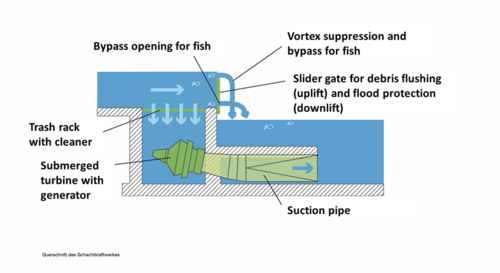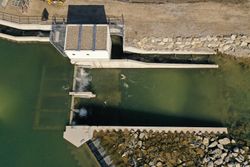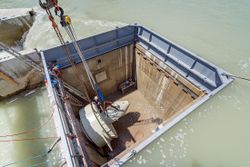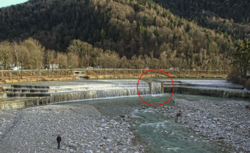Difference between revisions of "Shaft hydropower plant"
Bendikhansen (talk | contribs) |
Bendikhansen (talk | contribs) |
||
| Line 1: | Line 1: | ||
=Quick summary= | =Quick summary= | ||
[[file:SHP_functionality.png|thumb|500px|Figure 1: Functionality of the HYDROSHAFT concept. (Copyright TU Munich)]] | [[file:SHP_functionality.png|thumb|500px|Figure 1: Functionality of the HYDROSHAFT concept. (Copyright TU Munich)]] | ||
| + | [[file:SHP_aerial1.jpg|thumb|250px|Figure 2: Aerial view of the 420kW HYDROSHAFT powerplant at the Loisach River in Großweil, Bavaria. Germany]] | ||
| + | [[file:SHP_aerial2.jpg|thumb|250px|Figure 3: Aerial view of the two shafts with four trash-rack modules at Großweil, Bavaria. Germany.]] | ||
| + | [[file:SHP_install.jpg|thumb|250px|Figure 4: Setting in place of the 420kW turbine. Instead of classical stop-logs a metal shield holds the shaft dry for mounting and revisions]] | ||
| + | [[file:SHP_planned.png|thumb|250px|Figure 5: Visualization of the planned 300kW HYDROSHAFT powerplant at the historic Luitpold weir at the Saalach River in Bad-Reichenhall, Bavaria. Germany.]] | ||
Date: 2020 | Date: 2020 | ||
Revision as of 14:54, 9 October 2020
Contents
Quick summary
Date: 2020
Developed by: TU Munich, Chair of Hydraulic and Water Resources Engineering, Peter Rutschmann, Albert Sepp
Type: Device
Introduction
The HYDROSHAFT Powerplant is an innovative, fish-friendly hydropower concept, characterized by a horizontal rack, a submerged Kaplan turbine and a bypass for fish downstream migration immediately at the turbine intake. The hydropwer plant was originally developed to use existing non-gated weirs or ramps for hydropower generation. The HYDROSHAFT powerplant has a very simple geometry, doesn’t require a powerhouse and is therefore hardly visible or audible. It’s advantage for fish protection and ecology are the low velocities at the trash rack, the behavioral barrier through the horizontal fine-rack, the bypass for fish downstream migration and the possibility to pass all sediments over the shaft into the downstream.
Application
The HYDROSHAFT powerplant can use existing weirs or ramps but is also suitable to develop new hydropower at untouched rivers by the so-called multi-shaft concept. In the multi-shaft concept several shafts are combined with a so-called eco-migration corridor for fish and aquatic-sprecies migration. Due to its simple geometry the concept can be standardized and eventually prefabricate. Through the use of one or multiple shafts respectively the concept is scalable from small decentralized units up to large powerplants.
The powerplant has been extensively tested in the Lab of TU Munich in Obernach, where a 35kW pilot was built. Another equally sized pilot is situated at Voith Hydro in Heidenheim, Germany. The first larger powerplant is since February 2020 operational and feeds into the grid. It is located in Großweil, Bavaria, Germany at the Loisach River.
The HYDROSHAFT powerplant was tested in the Lab for its functionality, for the efficiency, for developing a suitable underwater trash-rack cleaner and for testing bypass migration routes and survival rates of fish. As a result of these investigations the following points are mentioned:
- The overall efficiency (measured at the clamp to theoretical) was measured 87%
- A completely new trash rack cleaner has been developed with MUHR HYDRO, Rosenheim, Germany
- The bypass into the downstream was used by most fishes and therefore overall mortality of the concept is very low
Due to the experimentally proven high survival rates the first plant at the Loisach River in a Natura 2000 reserve was possible. Also at the Iller River the highest German administrative court supported the granted water right without amendment. Whereas the first plant at the Loisach River was constructed in a very classical way the efforts are now intensified to lower costs by standardization. The next powerplant at the Iller River, Bavaria, Germany, will already economically work without subsidies. The final goal is to reach a price of about 5 Euro-Cents per KWh.
Relevant mitigation measures and test cases
| Relevant measures | |
|---|---|
| Bottom-type intakes (Coanda screen, Lepine water intake, etc) | |
| By-passing sediments | |
| Fish lifts, screws, locks, and others | |
| Fishways for eels and lampreys | |
| Migration barrier removal | |
| Other types of fine screens | |
| Sediment sluicing | |
| Relevant test cases | Applied in test case? |
| N/A | - |
Other information
The HYDROSHAFT powerplant is protected by several patent families. Licences and engineering design support are exclusively provided by Hydroshaft GmbH, Goethestraße 43, 80336 München, Germany. (https://www.hydroshaft.com)
Relevant literature
- Geiger F, Sepp A, Cuchet M, Rutschmann P, (2019) The TUM Hydro Shaft Power Plant – An Innovative Concept for efficient and ecological Hydropower. Hydro Energy & Sustainability Conference (HydroES 2019). What future for hydropower in France and in Europe(ed Société Hydrotechnique de France, (SHF), Paris, France, http://www.shf-hydro.org/225-1-hydroes_2019_what_future_for_hydropower_in_france_and_in_europe-72.html), (https://www.fithydro.eu/hydroes2019/), Session 2 - Part 3: *Hydropower, an energy for the future, 6 pages, Grenoble, France
- Rutschmann P, Sepp A, Hackl C (2019) First experiences with a 420 kW TUM Hydroshaft plant in the Bavarian Alps. Hydro 2019. International Conference and Exhibition. Session 28 – Small hydro: Innovations and challenges. (ed Alison Bartle), Porto, Portugal, www.hydropower-dams.com/hydro-2019
- Rutschmann P, Godde D, Sepp A (2019) Small low-head hydro in a container. Africa 2019 ~ Water Storage and Hydropower Development for Africa. Windhoek, Namibia. Session 19, Small hydro
- Sepp A, Rutschmann P (2017) Ökologisches Wasserkraftkonzept „Schachtkraftwerk“. Ingenieur-Spiegel, 65-67
- Geiger F, Cuchet M, Rutschmann P (2016) Experimental investigation of fish downstream passage and turbine related fish mortality at an innovative hydro power setup. (Étude expérimentale de la dévalaison des poissons et du taux de mortalité au passage d'une centrale hydroélectrique de conception innovante.) La Houille Blanche, 44-47, DOI 10.1051/lhb/2016059, https://doi.org/10.1051/lhb/2016059
- Geiger F, Sepp A, Rutschmann P (2016) Fischabstiegsuntersuchungen am Schachtkraftwerk. Korrespondenz Wasserwirtschaft, 9, 627-632, DOI: 10.3243/kwe2016.10.005
- Sepp A, Geiger F, Rutschmann P (2016) Schachtkraftwerk – Konzept und Funktionskontrollen. Korrespondenz Wasserwirtschaft, 9, 619-626, DOI: 10.3243/kwe2016.10.004
- Rutschmann P, Sepp A, Geiger F, Barbier J (2011) Das Schachtkraftwerk – ein Wasserkraftkonzept in vollständiger Unterwasseranordnung. Wasserwirtschaft, 101, 33-36.
- Rutschmann P, Sepp A, Geiger F, Barbier J (2011) A new take on hydro power design. International Water Power & Dam Construction, 63, 22-25.




